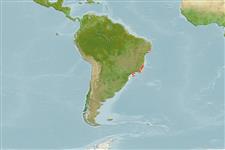Classificação / Names
Nomes comuns | Sinônimos | Catalog of Fishes(Gênero, Espécies) | ITIS | CoL | WoRMS | Cloffa
>
Eupercaria/misc (Various families in series Eupercaria) >
Labridae (Wrasses) > Corinae
Etymology: Halichoeres: Greek, als, alis = salt + Greek, choiros = pig (Ref. 45335); sazimai: Named for Dr. Ivan Sazima..
Environment: milieu / climate zone / depth range / distribution range
Ecologia
marinhas; intervalo de profundidade 20 - 70 m (Ref. 80967). Tropical
Southwest Atlantic: Brazil.
Tamanho / Peso / Idade
Maturity: Lm ? range ? - ? cm
Max length : 21.4 cm SL macho/indeterminado; (Ref. 80967)
Descrição suscinta
Morfologia | Morfometria
Espinhos dorsais (total): 9; Raios dorsais (total): 11; Espinhos anais 3; Raios anais : 12; Vértebras: 24. This specie sis distinguished by the following characters: D IX,11; A III,12; pectoral rays 13; caudal rays 14; lateral line scales 27; body y white with a stripe running on midline of the body from the snout, through the eye to tail; stripe straight, broadest and continuous from the snout to the shoulder, when it turns into a line of close-set spots in a zigzag pattern in alternate scales of 2 adjoining rows; terminal phase have the stripe entirely black or black at the first half becoming brownish, some with golden spots above and below scales, body darkened in the dorsum and the abdomen, becoming grayish or greenish in the area just above the mid-body stripe to the base of the dorsal fin; at the initial phase, the stripe is brown on the first third of its length and yellow to golden on the last two thirds (Ref. 80967).
Maximum depth from Ref. 126840. This species was observed foraging solitary on sand bottoms immediately adjacent to the lower end of rocky reefs. Harems that are composed of a few (5-10) individuals are not common but occasionally seen. This fish sometimes venture over the reefs, but generally never shallower than 20 m depth depending on water temperature (they seem to be associated with temperatures lower than 18°C). It also forages mostly on mobile invertebrates on soft and hard substratum, being more commonly observed foraging on sand bottoms and this behavior makes it a potential nuclear species in following associations, as it has been observed in other species of Halichoeres (Ref. 80967).
Ciclo de vida ou comportamento de acasalamento
Maturidade | Reprodução | Desova | Ovos | Fecundidade | Larvas
Distinct pairing during breeding (Ref. 205).
Luiz, O.J. Jr., C.E.L. Ferreira and L.A. Rocha, 2009. Halichoeres sazimai, a new species of wrasse (Perciformes: Labridae) from the Western South Atlantic. Zootaxa 2092:37-46. (Ref. 80967)
Status na Lista Vermelha da UICN (Ref. 130435)
Ameaça para os humanos
Harmless
Uso pelos humanos
Mais informação
Nomes comunsSinônimosMetabolismoPredadoresEcotoxicologiaReproduçãoMaturidadeDesovaAgregação de desovaFecundidadeOvosDesenvolvimento dos ovos
Idade/TamanhoCrescimentoPeso-comprimentoComprimento-comprimentoFrequências de comprimentoMorfometriaMorfologiaLarvasDinâmica larvalRecrutamentoAbundânciaBRUVS
ReferênciasAquaculturaPerfil para aquaculturaEstirpesGenéticaElectrophoresesHereditariedadeDoençasProcessamentoNutrientsConversão de massa
ColaboradoresFotosStamps, Coins Misc.SonsCiguateraVelocidadeTipo de nataçãoÁrea branquialOtólitosCérebrosVisão
Ferramentas
Relatórios especiais
Baixar XML
Fontes da internet
Estimates based on models
Preferred temperature (Ref.
123201): 21.6 - 27.2, mean 23.8 °C (based on 6 cells).
Índice de diversidade filogenética (Ref.
82804): PD
50 = 0.5000 [Uniqueness, from 0.5 = low to 2.0 = high].
Bayesian length-weight: a=0.00955 (0.00451 - 0.02020), b=3.09 (2.92 - 3.26), in cm total length, based on LWR estimates for this Genus-body shape (Ref.
93245).
Nível Trófico (Ref.
69278): 3.6 ±0.5 se; based on size and trophs of closest relatives
Resiliência (Ref.
120179): médio(a), tempo mínimo de duplicação da população 1,4 - 4,4 anos (Preliminary K or Fecundity.).
Fishing Vulnerability (Ref.
59153): Low vulnerability (16 of 100).
